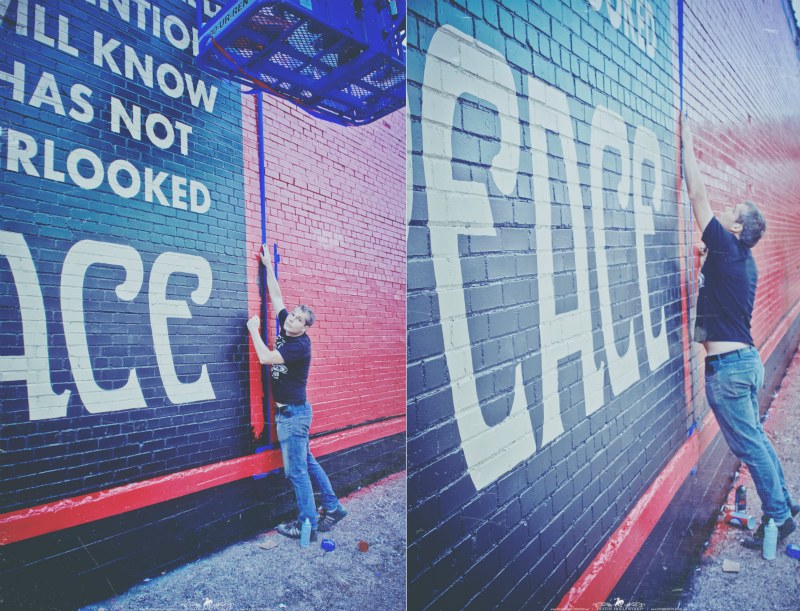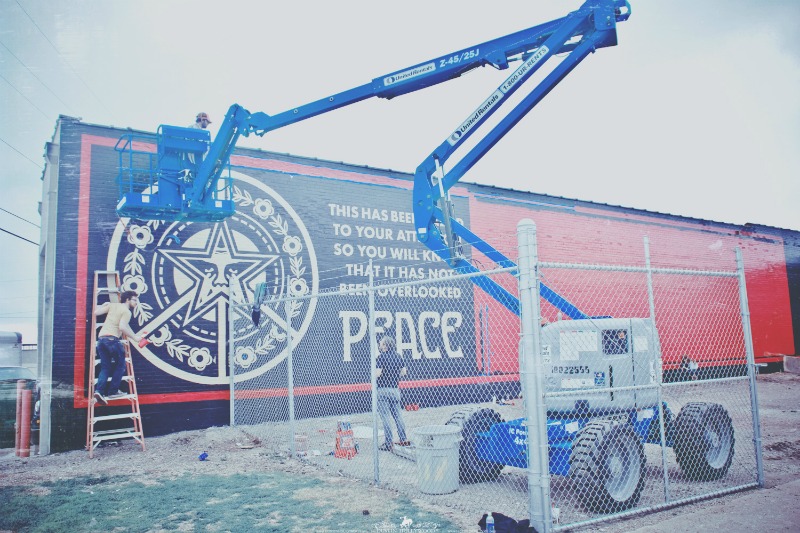Two Local Artists Sound Off On Shepard Fairey's Dallas Murals.
Though he's been arrested 16 times in his lifetime for various acts of vandalism, Shepard Fairey's latest trio of Dallas murals were done in broad daylight and with the city's support. Yup, the street artist most known for his Barack Obama 'HOPE' campaign posters and “OBEY” propaganda was recently in town painting a trio of officially-sanctioned murals as part of a project commissioned by the Dallas Contemporary museum.
Though the popular artist's recent Dallas additions were based around the innocuous subject of peace, they were still not totally without controversy.
On the one hand, the highly buzzed-about works by such a noteworthy artist indeed draws attention to Dallas' burgeoning underground art scene — especially to those who may not normally pay attention to this brand of street art. But does the importation of an out-of-town artist necessarily benefit Dallas street art in the long-term?
To answer this question we spoke with local artists Kevin Obregon and Angelo Gonzalez to weigh in on Fairey's visit.
Kevin Obregon: Long term, I don't see how having Shepard's work here literally hurts the local art scene any more than having one of my murals in L.A. hurts the L.A. art scene. If anything, it has perhaps given a more tangible strength to the word “mural” in many people's lexicon — especially local building owners where there is often a disconnect.
Short term, yeah, I heard first hand and participated in some pretty animated conversations with several local and regional artists regarding his presence in Dallas, and felt it was mostly polarized with admirers and haters. I don't think it's the end of the world to have a noted international artist's work seen within the public realm, but it should stir greater impetus among local graffiti writers and muralists to step up and decide to be seen as a counter-punch or a peer. Within the context of the DMA, the Nasher and the Contemporary all showing L.A. artists in the same month in Dallas, yes, that too seems a little L.A.-envious. It comes across as Dallas being a weigh station for other cities' talents.
As far as the disconnect between muralists and building owners goes, is this possibly an area where Fairey has a somewhat positive impact? With so much high profile attention and press coverage this past week, does it sort of cast street artists and muralists in a more positive light to property owners and the general public? Might this increase opportunities for local artists to contribute works more frequently throughout the city?
Obregon: First of all, yes, I think Fairey's presence — even if he's not a local — seems to have amplified the genre to some building owners. And judging from the community response, there is a tremendous fire being lit under some artist's collective butts to offer a local counter-punch. That's a good thing to me. Insofar as casting artists and muralists in a more positive light, that's a possibility, although I can't speak for everyone. Some building owners don't want graffiti and others do. It's a matter of personal taste. I have talked with property owners who are pretty vocal in that they do not want anything “sub-standard,” but they often don't have the money to pay a professional muralist or graffiti writer.
I do think the geography does have something to do with the fervor — in that West Dallas is essentially a Tabula Rasa and many feel the void should be filled with local artists. I just happen to think there's an opportunity for muralists and graff writers from all over the world here, and that's one of my goals. The trick, of course, is how we fund these projects so we're not conditioning building owners to believe murals can be had free of charge. That's not a sustainable model. That said, if there is no budget for publicly-accessed street art, chances are it will get done fast, cheap and illegally anyway. Then the graffiti czar comes out with his five-gallon buckets of ship Gray, making his own de facto public art statement. I'd rather see legal walls created where the cream rises to the top. Perhaps a vast playground of street art where all but the best pieces get buffed?
Angelo Gonzalez: Personally, I think it's a good thing to have out-of-town artists come and do commissioned pieces. Aside from Shepard Fairey, Dallas was also lucky to be graced by the work of graffiti artist Eine with his “Great Adventures In Texas” piece, but unfortunately it was pretty slept on. I know a lot of graff artists that don't consider Shepard Fairey a “legit” graffiti artist, but rather a rouge pop art graphic designer. His work seems to be more of an elaborate billboard (complete with hired installers) than actual art. However, I do hope this opens up more communication between business owners and artist and hopefully more opportunity for local artist like Sour Grapes Crew, Infinite Crew, Painted Family or Steve Hunter (all of which have done commissioned work and have worked hard to do things legally).
Ultimately, it's up to business owners to trust the artist and take the risk, but understand that they would be opening the doors for furthering Dallas art. But, until then, you'll keep seeing bombs and throw-ups and extinguisher pieces from ambitious guys like Vacant, Creep, Ceno, Slums, and other extremely talented artist who have no other outlet. I would like to see more free walls, too.
Obregon: Outlets exist everywhere. What is the ultimate outlet, anyway? Free walls? Commercial galleries? Street galleries (overpasses)? Museums? Train cars? Artists who think in self-defeating ways are apparently doing whatever they want to produce as artists anyway, and will go as far as they fear, whether it's a tag, throw-up or piece. Hey, if showing your best work in the public arena represents the ultimate “outlet,” do it! It's not illegal to create graffiti. It's just illegal to to it on public and private property without permission. Work at your own risk.
As an aside, there are additional useful functions in illegal tagging, in that they often represent social markers that there are areas that are in neglect by business owners or municipalities and need attention. (See: “broken window theory.”) But the truth is you can't lament that there are “no options” out there as an excuse to create less than your best pieces. There are thousands of outlets; it's called commissions. I think we all should be getting paid for our talent. But it means hustling our work to building and business owners if we want to do this for a living, or want greater exposure, let alone funds to support our craft. If we do wish to give it away, that's our prerogative, but it should not be because accepting money is considered “selling out.” That's ridiculous.
With regards to legal walls, I do advocate for them, but with a pretty common sense caveat; artists should strive to do their best work and get flicks before someone else paints over it. Put the flicks on your Facebook page, blog or website. Show what you can do if given the time and the commissions will manifest on walls where they won't get buffed and you will get paid, quid pro quo. Free or legal walls do work in some cities where artists respect them. It has failed in other cities where either the designated wall spaces were too small and it overflowed or where the artists took their inch and gave it a mile and tagged areas way beyond the walls. In my opinion, free and legal walls should be about a visual dialogue — not unlike slam poetry — done with respect, spontaneity, talent and a mutual appreciation that there is a platform for its discourse.
Lastly, my dream would be to see the works of graffiti artists and muralists from every talented local writer and muralist alongside others from all over the world right here in Dallas. I envision areas of the Metroplex where you can spend days walking, biking and driving around looking at these works and never see them all. If you want to see it done right, look at Melbourne, Australia. There's a city that respects and integrates its street artists and crews. What's unique about Melbourne's streets is that there is definitive system of the best artists getting prime wall real estate and side streets getting those who are working their way up, while the back alleys get those who are beginners or are perfecting their skills. We're on our way, though, and I know the Dallas Police Department is striving for legal solutions, not further vilification.
Gonzalez: The truth is there is a difference between graffiti and vandalism. People write their names on walls to be seen and to gain recognition. On the issue of free walls, it encourages people who have never painted to go out and try their hand, it gives other artist a chance to practice and perfect their craft and it gives the public a chance to see the progression of it all. Are free walls the answer? No, but it's a start, a place people can go when they get the urge to paint at 4 a.m., a place people can go and snap photos and collect names and look up to local artist the way I did when I saw Ozone's piece in Expo Park or the way I used to look at Minus' work or Abyss' work. These guys and the rest of IC crew were like gods to me, and, yeah, they did illegal spots. But it's the flicks I got from Ace that made Deep Ellum a repeat destination for me. It's the reason I frequent the Ferguson/Oates wall today. Yes, Melbourne is a perfect example and I would hope to see something similar here — even a designated underpass. I'd even pay to go to a graffiti park.
Vandalism is a crime, Graffiti isn't. But the value of either as art is up to the people, be it the artist, business owner, police, or spectator. Designating spots allows people to make up their minds worry free, to an extent.
Obregon: All great points, Angelo! And, for the record, when I was managing Nine Eyes Studio, my first gallery near Deep Ellum, I held IC Crew's 10th Anniversary show and thought their work was amazingly individual, cohesive as a collective and powerful within the genre. Minus was a special human being and it's obvious the love he gave to everyone was reciprocated, as evidenced by the outpouring of emotion in his passing.
I do foresee legal walls being done here, it's just a matter of time. I am impressed the DPD is concerned over reducing the amount of convictions of taggers and writers, but from a municipal POV, it has to be a concerted effort between code enforcement, the police, building owners, city council members, artists and advocates for the artists. Respect goes both ways, and I have seen all parties act out against one another and it does a disservice to those who want to pursue their goals as street artists (legally or otherwise) and as those who are paid to enforce the laws and peoples' personal property. That “covenant” needs to be respected, so therefore “legal walls” would likely have a positive effect for everyone if done thoughtfully and placed well.
All photos by Dustin Hollywood.


















































